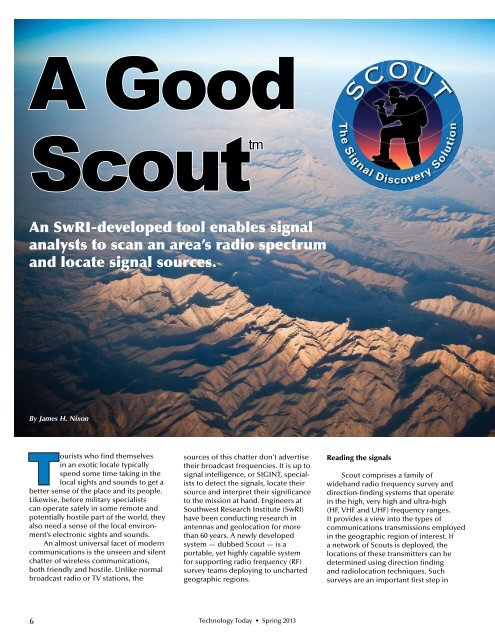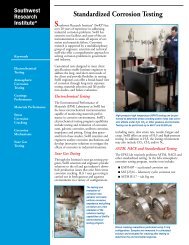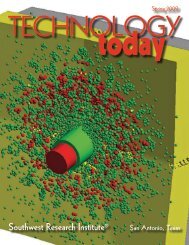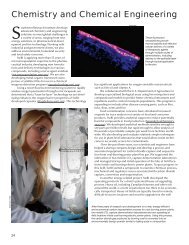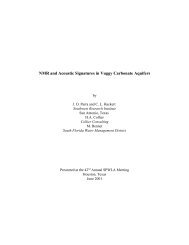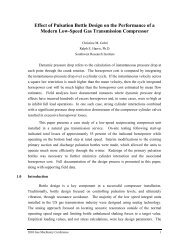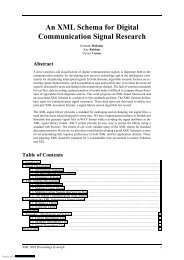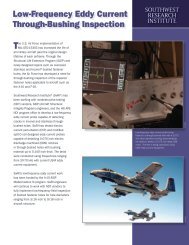An SwRI-developed tool enables signal analysts to scan an area's ...
An SwRI-developed tool enables signal analysts to scan an area's ...
An SwRI-developed tool enables signal analysts to scan an area's ...
Create successful ePaper yourself
Turn your PDF publications into a flip-book with our unique Google optimized e-Paper software.
A GoodScoutm<strong>An</strong> <strong>SwRI</strong>-<strong>developed</strong> <strong><strong>to</strong>ol</strong> <strong>enables</strong> <strong>signal</strong><strong><strong>an</strong>alysts</strong> <strong>to</strong> <strong>sc<strong>an</strong></strong> <strong>an</strong> area’s radio spectrum<strong>an</strong>d locate <strong>signal</strong> sources.By James H. NixonTourists who find themselvesin <strong>an</strong> exotic locale typicallyspend some time taking in thelocal sights <strong>an</strong>d sounds <strong>to</strong> get abetter sense of the place <strong>an</strong>d its people.Likewise, before military specialist<strong>sc<strong>an</strong></strong> operate safely in some remote <strong>an</strong>dpotentially hostile part of the world, theyalso need a sense of the local environment’selectronic sights <strong>an</strong>d sounds.<strong>An</strong> almost universal facet of moderncommunications is the unseen <strong>an</strong>d silentchatter of wireless communications,both friendly <strong>an</strong>d hostile. Unlike normalbroadcast radio or TV stations, thesources of this chatter don’t advertisetheir broadcast frequencies. It is up <strong>to</strong><strong>signal</strong> intelligence, or SIGINT, specialists<strong>to</strong> detect the <strong>signal</strong>s, locate theirsource <strong>an</strong>d interpret their signific<strong>an</strong>ce<strong>to</strong> the mission at h<strong>an</strong>d. Engineers atSouthwest Research Institute (<strong>SwRI</strong>)have been conducting research in<strong>an</strong>tennas <strong>an</strong>d geolocation for moreth<strong>an</strong> 60 years. A newly <strong>developed</strong>system — dubbed Scout — is aportable, yet highly capable systemfor supporting radio frequency (RF)survey teams deploying <strong>to</strong> unchartedgeographic regions.Reading the <strong>signal</strong>sScout comprises a family ofwideb<strong>an</strong>d radio frequency survey <strong>an</strong>ddirection-finding systems that operatein the high, very high <strong>an</strong>d ultra-high(HF, VHF <strong>an</strong>d UHF) frequency r<strong>an</strong>ges.It provides a view in<strong>to</strong> the types ofcommunications tr<strong>an</strong>smissions employedin the geographic region of interest. Ifa network of Scouts is deployed, thelocations of these tr<strong>an</strong>smitters c<strong>an</strong> bedetermined using direction finding<strong>an</strong>d radiolocation techniques. Suchsurveys are <strong>an</strong> import<strong>an</strong>t first step in6 Technology Today • Spring 2013
Pho<strong>to</strong> courtesy DODD018916-2778James H. Nixon is direc<strong>to</strong>r of the SIGINT SolutionsDepartment in <strong>SwRI</strong>’s Signal Exploitation <strong>an</strong>d GeolocationDivision. He leads the design, development <strong>an</strong>d deploymen<strong>to</strong>f modern radio communications intelligence solutions. Hisexpertise includes wideb<strong>an</strong>d <strong>an</strong>d narrowb<strong>an</strong>d <strong>signal</strong>acquisition <strong>an</strong>d direction-finding systems.One aspect of the Scout system is <strong>an</strong> <strong>SwRI</strong>-<strong>developed</strong>function known as “Prospec<strong>to</strong>r,” whose user interface allowsthe opera<strong>to</strong>r <strong>to</strong> select from a s<strong>to</strong>red display of radio frequencyactivity over the past 24 hours.underst<strong>an</strong>ding <strong>an</strong> adversary’s modesof communication <strong>an</strong>d preparingmilitary <strong>an</strong>d intelligence sources for theelectronic battlefield.SIGINT is derived from electronic<strong>signal</strong>s <strong>an</strong>d systems used by adversariesfor communications systems, radars<strong>an</strong>d weapons systems. It provides a vitalwindow in<strong>to</strong> the capabilities, actions <strong>an</strong>dintentions of adversaries. A category ofSIGINT called communications intelligence,or COMINT, focuses on exploiting<strong>an</strong> adversary’s communications <strong>signal</strong>s.These types of <strong>signal</strong>s include voice,Morse code <strong>an</strong>d m<strong>an</strong>y digitally coded<strong>signal</strong>s, such as those used by cellphones <strong>an</strong>d data modems.Scout includes a radio <strong>an</strong>tenna,special radio <strong>signal</strong> tuners <strong>an</strong>d a numberof high-perform<strong>an</strong>ce servers similar <strong>to</strong>those used by information technologyTechnology Today • Spring 2013 7
<strong>An</strong> opera<strong>to</strong>r c<strong>an</strong> select a single RF <strong>signal</strong> (left<strong>to</strong>p pho<strong>to</strong>) for <strong>an</strong>alysis by Scout software(right bot<strong>to</strong>m pho<strong>to</strong>).D019013data centers <strong>an</strong>d for scientific research.Once the radio spectrum is digitallyconverted <strong>to</strong> ones <strong>an</strong>d zeros by thespecial wide-b<strong>an</strong>dwidth radio receiverhardware, the digitized radio spectrum istr<strong>an</strong>sferred over a high-capacity local are<strong>an</strong>etwork <strong>to</strong> <strong>an</strong> array of computer servers.<strong>SwRI</strong>-<strong>developed</strong> software running onthese servers performs a number of<strong>signal</strong> processing steps needed <strong>to</strong> takethe raw RF environment <strong>an</strong>d tr<strong>an</strong>sformit <strong>to</strong> useful information. The first step inthis process is <strong>to</strong> au<strong>to</strong>matically detect<strong>signal</strong> events occurring <strong>an</strong>ywherewithin the frequency coverage ofthe system. Once such energy hasbeen detected, the system builds asoftware radio receiver that filters<strong>an</strong>d isolates the new energy in<strong>to</strong> <strong>an</strong>arrow-b<strong>an</strong>d ch<strong>an</strong>nel.Adding a sense of directionThe Scout system c<strong>an</strong>construct hundreds of thesech<strong>an</strong>nels simult<strong>an</strong>eously. Oncethe new energy has been ch<strong>an</strong>nelized,it is routed <strong>to</strong> one of m<strong>an</strong>ymission prosecu<strong>to</strong>r softwareservices. Within these missionprosecu<strong>to</strong>rs,the ch<strong>an</strong>nelis au<strong>to</strong>matically<strong>an</strong>alyzedby <strong>SwRI</strong><strong>developed</strong>modulation recognition software <strong>to</strong>determine the general type of modulationemployed <strong>an</strong>d ascertain whether theenergy comes from a voice, Morse codeor digital modem <strong>signal</strong>, <strong>an</strong>d what kindsof digital modulation techniques arebeing employed. Additional processing isapplied <strong>to</strong> digitally modulated <strong>signal</strong>s <strong>to</strong>further refine the identification process,ultimately resulting in a determination ofthe specific type of modem employed,<strong>an</strong>d in some cases, the underlying datapro<strong>to</strong>cols in use.D019028Scout operates across the RFspectrum, as shown in this usageallocation chart.8Technology Today • Spring 2013
If the digital <strong>signal</strong> is recognizedby the system, it is thendemodulated <strong>an</strong>d decoded <strong>to</strong>extract the underlying data beingcommunicated. Even <strong>signal</strong>s thatare not part of the Scout <strong>signal</strong>-ofinterestlibrary are catalogued. Thisinformation c<strong>an</strong> help the userdiscover new <strong>signal</strong>s of interest. Ifthe unit is equipped with theradio direction-finding option, aline of bearing is computed fromthe Scout’s location <strong>to</strong> the radiotr<strong>an</strong>smitter. Moreover, a numberof Scouts c<strong>an</strong> be networked<strong>to</strong>gether <strong>an</strong>d the various lines ofbearing c<strong>an</strong> be tri<strong>an</strong>gulated so thatthe radio tr<strong>an</strong>smitter’s estimatedlocation c<strong>an</strong> be computed.The final results are s<strong>to</strong>red in adatabase. Web browser-based<strong><strong>to</strong>ol</strong>s are provided with the system<strong>to</strong> allow <strong>an</strong>y authorized user onthe Scout network access <strong>to</strong> thecollection results.Record now, playback laterScout also supports m<strong>an</strong>ualsearch <strong>an</strong>d user-driven <strong>signal</strong>discovery operations. Theau<strong>to</strong>matic RF environmentcataloguing operation requiresthat the user already know m<strong>an</strong>ydetails about the <strong>signal</strong>s ofinterest. In m<strong>an</strong>y cases the typesof <strong>signal</strong>s are known, <strong>an</strong>d the au<strong>to</strong>maticsearch capability will confirm that theyexist in the geographic region of interest.However, if <strong>an</strong> adversary deploys <strong>an</strong>ewly invented <strong>signal</strong> waveform, theau<strong>to</strong>matic system may not identifythose emissions or characterize them inenough detail <strong>to</strong> assist the user. For thesesituations, the <strong>SwRI</strong> team <strong>developed</strong>a graphical user interface (GUI) <strong><strong>to</strong>ol</strong>,called Prospec<strong>to</strong>r, which is deployedwith Scout <strong>to</strong> enable the opera<strong>to</strong>r <strong>to</strong>visualize the RF environment <strong>an</strong>d searchfor interesting <strong>an</strong>d unique <strong>signal</strong> activity.This is accomplished by s<strong>to</strong>ring thelast 24 hours of RF spectrum on Scout’sinternal hard drive. <strong>An</strong> opera<strong>to</strong>r who sees<strong>an</strong> interesting <strong>signal</strong> event c<strong>an</strong> simplydraw a box around the <strong>signal</strong> <strong>an</strong>d Scoutconstructs a software radio on the spotthat ch<strong>an</strong>nelizes the <strong>signal</strong> <strong>an</strong>d presentsthe waveform in <strong>an</strong>other <strong>SwRI</strong>-<strong>developed</strong><strong><strong>to</strong>ol</strong> called Tass. Tass provides a multitudeof <strong>signal</strong> <strong>an</strong>alysis <strong><strong>to</strong>ol</strong>s that enable thebreakdown of <strong>signal</strong> structures, includingdemodulation of fundamental modulationschemes. Scout’s ability <strong>to</strong> s<strong>to</strong>re theD018916-2860entire radio-frequency environmen<strong>to</strong>n disk <strong>an</strong>d ch<strong>an</strong>nelize <strong>an</strong>y part of thespectrum at will is akin <strong>to</strong> having “TiVo®on steroids” — except that instead ofs<strong>to</strong>ring only your favorite ch<strong>an</strong>nels, Scouts<strong>to</strong>res everything on the RF spectrum,enabling the opera<strong>to</strong>r <strong>to</strong> reconstruct <strong>an</strong>ykind of <strong>signal</strong> event after the fact.Combining capabilities of earlier systemsOriginally <strong>developed</strong> <strong>to</strong> replacea now-retired system, Scout not onlyexceeds its predecessor’s capabilities inau<strong>to</strong>matic detection of known <strong>signal</strong>s ofinterest, but also has a fully integrateddirection-finding capability. The way<strong>signal</strong>s are described in Scout is compatiblewith U.S. Department of Defenseformats, enabling Scout <strong>to</strong> leverage new<strong>signal</strong>s as they are <strong>developed</strong> by others.Additionally, 24 hours of RF environments<strong>to</strong>rage <strong>an</strong>d a GUI enable the user<strong>to</strong> m<strong>an</strong>ually scour the last 24 hours ofRF activity <strong>an</strong>d reconstruct <strong>an</strong>d locate a<strong>signal</strong> event. This capability was previouslyperformed by other systems thatwere separate from Scout’s predecessor.<strong>An</strong> <strong>SwRI</strong> engineer prepares aScout system for operation. Theunit is much more compact th<strong>an</strong>earlier systems.Scout does a job thatpreviously required a numberof systems from multiplevendors. By combiningau<strong>to</strong>matic search <strong>an</strong>d <strong>signal</strong>identification functionswith a m<strong>an</strong>ual search <strong><strong>to</strong>ol</strong>,Scout reduces the hardwareresources required <strong>to</strong> supportRF survey missions <strong>an</strong>d alsoreduces the cost.Scout is based on commerciallyavailable, high-perform<strong>an</strong>ceservers widely used indata centers across the globe. All of the<strong>signal</strong> processing required <strong>to</strong> supportthe operating modes consists of softwarerather th<strong>an</strong> expensive special-purposeprocessing components such as those<strong>developed</strong> for the aerospace industry. Thiscombination of commodity hardware <strong>an</strong>da software-defined framework gives Scout<strong>an</strong> unprecedented level of scalability <strong>an</strong>dexp<strong>an</strong>dability. Leveraging the commercialcomputer market allows the use of thelatest computer technology with minimalrisk of obsolescence <strong>an</strong>d keeps costseconomical, while taking adv<strong>an</strong>tage of thelatest breakthroughs in the globally drivencomputer market.Although Scout’s primary applicationis in support of U.S. <strong>an</strong>d allied military, lawenforcement <strong>an</strong>d intelligence communities,potential commercial applicationscould include surveying other types ofradio spectrum <strong>signal</strong>s, such as electromagneticinterference emissions fromindustrial <strong>an</strong>d power distribution sources.Questions about this article? ContactNixon at (210) 522-2619 orjim.nixon@swri.org.Technology Today • Spring 2013 9


